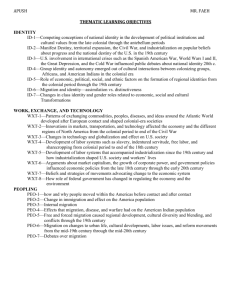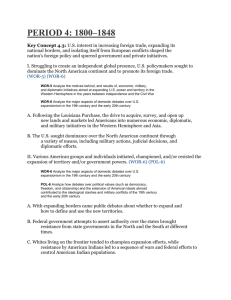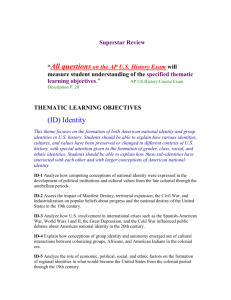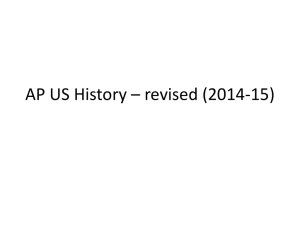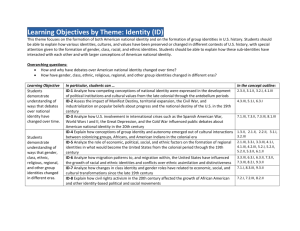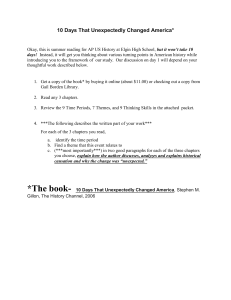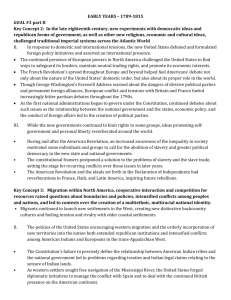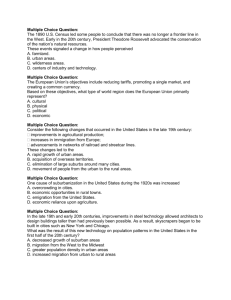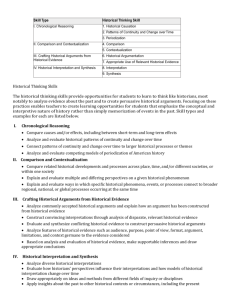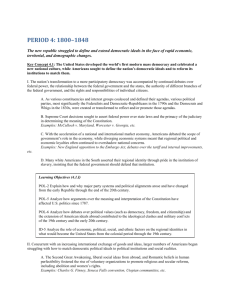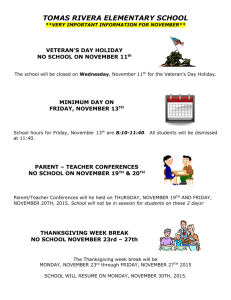thematic learning objectives - Somerset Academy Silver Palms
advertisement
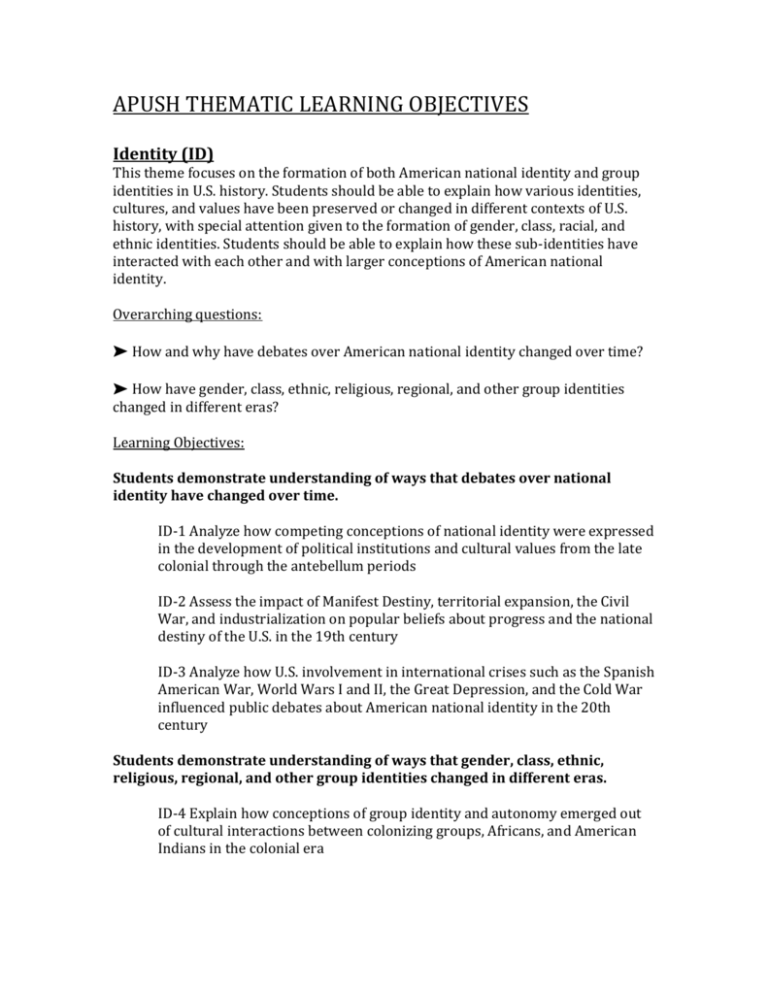
APUSH THEMATIC LEARNING OBJECTIVES Identity (ID) This theme focuses on the formation of both American national identity and group identities in U.S. history. Students should be able to explain how various identities, cultures, and values have been preserved or changed in different contexts of U.S. history, with special attention given to the formation of gender, class, racial, and ethnic identities. Students should be able to explain how these sub-identities have interacted with each other and with larger conceptions of American national identity. Overarching questions: ➤ How and why have debates over American national identity changed over time? ➤ How have gender, class, ethnic, religious, regional, and other group identities changed in different eras? Learning Objectives: Students demonstrate understanding of ways that debates over national identity have changed over time. ID-1 Analyze how competing conceptions of national identity were expressed in the development of political institutions and cultural values from the late colonial through the antebellum periods ID-2 Assess the impact of Manifest Destiny, territorial expansion, the Civil War, and industrialization on popular beliefs about progress and the national destiny of the U.S. in the 19th century ID-3 Analyze how U.S. involvement in international crises such as the Spanish American War, World Wars I and II, the Great Depression, and the Cold War influenced public debates about American national identity in the 20th century Students demonstrate understanding of ways that gender, class, ethnic, religious, regional, and other group identities changed in different eras. ID-4 Explain how conceptions of group identity and autonomy emerged out of cultural interactions between colonizing groups, Africans, and American Indians in the colonial era ID-5 Analyze the role of economic, political, social, and ethnic factors on the formation of regional identities in what would become the United States from the colonial period through the 19th century ID-6 Analyze how migration patterns to, and migration within, the United States have influenced the growth of racial and ethnic identities and conflicts over ethnic assimilation and distinctiveness ID-7 Analyze how changes in class identity and gender roles have related to economic, social, and cultural transformations since the late 19th century ID-8 Explain how civil rights activism in the 20th century affected the growth of African American and other identity-based political and social movements Work, Exchange, and Technology (WXT) This theme focuses on the development of American economies based on agriculture, commerce, and manufacturing. Students should examine ways that different economic and labor systems, technological innovations, and government policies have shaped American society. Students should explore the lives of working people and the relationships among social classes, racial and ethnic groups, and men and women, including the availability of land and labor, national and international economic developments, and the role of government support and regulation. Overarching questions: ➤ How have changes in markets, transportation, and technology affected American society from colonial times to the present day? ➤ Why have different labor systems developed in British North America and the United States, and how have they affected U.S. society? ➤ How have debates over economic values and the role of government in the U.S. economy affected politics, society, the economy, and the environment? Learning Objectives: Students demonstrate understanding of ways that changes in markets, transportation, and technology have affected American society. WXT-1 Explain how patterns of exchanging commodities, peoples, diseases, and ideas around the Atlantic World developed after European contact and shaped North American colonial-era societies WXT-2 Analyze how innovations in markets, transportation, and technology affected the economy and the different regions of North America from the colonial period through the end of the Civil War WXT-3 Explain how changes in transportation, technology, and the integration of the U.S. economy into world markets have influenced U.S. society since the Gilded Age Students demonstrate understanding of ways that different labor systems have developed over time. WXT-4 Explain the development of labor systems such as slavery, indentured servitude, free labor, and sharecropping from the colonial period through the end of the 18th century WXT-5 Explain the development of labor systems that accompanied industrialization since the 19th century and how industrialization shaped U.S. society and workers’ lives Students demonstrate understanding of debates over economic values and the role of government in the U.S. economy and how these debates affected politics, society, the economy, and the environment. WXT-6 Explain how arguments about market capitalism, the growth of corporate power, and government policies influenced economic policies from the late 18th century through the early 20th century WXT-7 Compare the beliefs and strategies of movements advocating changes to the U.S. economic system since industrialization, particularly the organized labor, Populist, and Progressive movements WXT-8 Explain how and why the role of the federal government in regulating economic life and the environment has changed since the end of the 19th century PEOPLING (PEO) This theme focuses on why and how the various people who moved to, from, and within the United States adapted to their new social and physical environments. Students examine migration across borders and long distances, including the slave trade and internal migration, and how both newcomers and indigenous inhabitants transformed North America. The theme also illustrates how people responded when “borders crossed them.” Students explore the ideas, beliefs, traditions, technologies, religions, and gender roles that migrants/immigrants and annexed peoples brought with them, and the impact these factors had on both these peoples and on U.S. society. Overarching questions: ➤ Why have people migrated to, from, and within North America? ➤ How have changes in migration and population patterns affected American life? Learning Objectives: Students demonstrate understanding of why people have migrated to, from, and within North America. PEO-1 Explain how and why people moved within the Americas (before contact) and to and within the Americas (after contact and colonization) PEO-2 Explain how changes in the numbers and sources of international migrants in the 19th and 20th centuries altered the ethnic and social makeup of the U.S. population PEO-3 Analyze the causes and effects of major internal migration patterns such as urbanization, suburbanization, westward movement, and the Great Migration in the 19th and 20th centuries Students demonstrate understanding of how changes in migration and population patterns have affected American life. PEO-4 Analyze the effects that migration, disease, and warfare had on the American Indian population after contact with Europeans PEO-5 Explain how free and forced migration to and within different parts of North America caused regional development, cultural diversity and blending, and political and social conflicts through the 19th century PEO-6 Analyze the role of both internal and international migration on changes to urban life, cultural developments, labor issues, and reform movements from the mid-19th century through the mid-20th century PEO-7 Explain how and why debates over immigration to the United States have changed since the turn of the 20th century Politics and Power (POL) Students should examine ongoing debates over the role of the state in society and its potential as an active agent for change. This includes mechanisms for creating, implementing, or limiting participation in the political process and the resulting social effects, as well as the changing relationships among the branches of the federal government and among national, state, and local governments. Students should trace efforts to define or gain access to individual rights and citizenship and survey the evolutions of tensions between liberty and authority in different periods of U.S. history. Overarching questions: ➤ How and why have different political and social groups competed for influence over society and government in what would become the United States? ➤ How have Americans agreed on or argued over the values that guide the political system, as well as who is a part of the political process? Learning Objectives: Students demonstrate understanding of how different political and social groups competed for influence over society and government in colonial North America and the United States. POL-1 Analyze the factors behind competition, cooperation, and conflict among different societies and social groups in North America during the colonial period POL-2 Explain how and why major party systems and political alignments arose and have changed from the early Republic through the end of the 20th century POL-3 Explain how activist groups and reform movements, such as antebellum reformers, civil rights activists, and social conservatives, have caused changes to state institutions and U.S. society POL-4 Analyze how and why the New Deal, the Great Society, and the modern conservative movement all sought to change the federal government’s role in U.S. political, social, and economic life Students demonstrate understanding of how Americans have agreed on or argued over the values that guide the political system, as well as who is a part of the political process. POL-5 Analyze how arguments over the meaning and interpretation of the Constitution have affected U.S. politics since 1787 POL-6 Analyze how debates over political values (such as democracy, freedom, and citizenship) and the extension of American ideals abroad contributed to the ideological clashes and military conflicts of the 19th century and the early 20th century POL-7 Analyze how debates over civil rights and civil liberties have influenced political life from the early 20th century through the early 21st century America in the World (WOR) In this theme, students should focus on the global context in which the United States originated and developed, as well as the influence of the U.S. on world affairs. Students should examine how various world actors (such as people, states, organizations, and companies) have competed for the territory and resources of the North American continent, influencing the development of both American and world societies and economies. Students should also investigate how American foreign policies and military actions have affected the rest of the world as well as social issues within the U.S. itself. Overarching questions: ➤ How have events in North America and the United States related to contemporary developments in the rest of the world? ➤ How have different factors influenced U.S. military, diplomatic, and economic involvement in international affairs and foreign conflicts, both in North America and overseas? Learning Objectives: Students demonstrate understanding of the relationship among events in North America and the United States and contemporary events in the rest of the world. WOR-1 Explain how imperial competition and the exchange of commodities across both sides of the Atlantic Ocean influenced the origins and patterns of development of North American societies in the colonial period WOR-2 Explain how the exchange of ideas among different parts of the Atlantic World shaped belief systems and independence movements into the early 19th century WOR-3 Explain how the growing interconnection of the U.S. with worldwide economic, labor, and migration systems affected U.S. society since the late 19th century WOR-4 Explain how the U.S. involvement in global conflicts in the 20th century set the stage for domestic social changes Students demonstrate understanding of how different factors have influenced U.S. military, diplomatic, and economic involvement in international affairs and foreign conflicts, both in North America and overseas. WOR-5 Analyze the motives behind, and results of, economic, military, and diplomatic initiatives aimed at expanding U.S. power and territory in the Western Hemisphere in the years between independence and the Civil War WOR-6 Analyze the major aspects of domestic debates over U.S. expansionism in the 19th century and the early 20th century WOR-7 Analyze the goals of U.S. policymakers in major international conflicts, such as the Spanish-American War, World Wars I and II, and the Cold War, and explain how U.S. involvement in these conflicts has altered the U.S. role in world affairs WOR-8 Explain how U.S. military and economic involvement in the developing world and issues such as terrorism and economic globalization have changed U.S. foreign policy goals since the middle of the 20th century Environment and Geography — Physical and Human (ENV) This theme examines the role of environment, geography, and climate in both constraining and shaping human actions. Students should analyze the interaction between the environment and Americans in their efforts to survive and thrive. Students should also explore efforts to interpret, preserve, manage, or exploit natural and man-made environments, as well as the historical contexts within which interactions with the environment have taken place. Overarching questions: ➤ How did interactions with the natural environment shape the institutions and values of various groups living on the North American continent? ➤ How did economic and demographic changes affect the environment and lead to debates over use and control of the environment and natural resources? Learning Objectives: Students demonstrate understanding of the various ways in which interactions with the natural environment shaped the institutions and values of various groups living in North America from prior to European contact through the Civil War. ENV-1 Explain how the introduction of new plants, animals, and technologies altered the natural environment of North America and affected interactions among various groups in the colonial period ENV-2 Explain how the natural environment contributed to the development of distinct regional group identities, institutions, and conflicts in the precontact period through the independence period ENV-3 Analyze the role of environmental factors in contributing to regional economic and political identities in the 19th century, and how they affected conflicts such as the American Revolution and the Civil War Students demonstrate understanding of how economic and demographic changes affected the environment and led to debates over use and control of the environment and natural resources. ENV-4 Analyze how the search for economic resources affected social and political developments from the colonial period through Reconstruction ENV-5 Explain how and why debates about and policies concerning the use of natural resources and the environment more generally have changed since the late 19th century Ideas, Beliefs, and Culture (CUL) This theme explores the roles that ideas, beliefs, social mores, and creative expression have played in shaping the United States. Students should examine the development of aesthetic, moral, religious, scientific, and philosophical principles, and consider how these principles have affected individual and group actions. Students should analyze the interactions between beliefs and communities, economic values, and political movements, including attempts to change American society to align it with specific ideals. Overarching questions: ➤ How and why have moral, philosophical, and cultural values changed in what would become the United States? ➤ How and why have changes in moral, philosophical, and cultural values affected U.S. history? Learning Objectives: Students demonstrate understanding of how and why moral, philosophical, and cultural values changed in what would become the United States. CUL-1 Compare the cultural values and attitudes of different European, African American, and native peoples in the colonial period and explain how contact affected intergroup relationships and conflicts CUL-2 Analyze how emerging conceptions of national identity and democratic ideals shaped value systems, gender roles, and cultural movements in the late 18th century and the 19th century CUL-3 Explain how cultural values and artistic expression changed in response to the Civil War and the postwar industrialization of the United States Students demonstrate understanding of how and why changes in moral, philosophical, and cultural values affected U.S. history. CUL-4 Analyze how changing religious ideals, Enlightenment beliefs, and republican thought shaped the politics, culture, and society of the colonial era through the early Republic CUL-5 Analyze ways that philosophical, moral, and scientific ideas were used to defend and challenge the dominant economic and social order in the 19th and 20th centuries CUL-6 Analyze the role of culture and the arts in 19th- and 20th-century movements for social and political change CUL-7 Explain how and why “modern” cultural values and popular culture have grown since the early 20th century and how they have affected American politics and society
